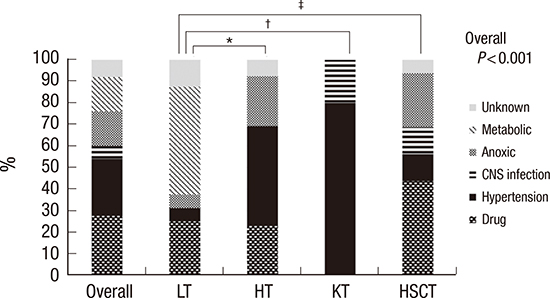2. Kang JM, Kim YJ, Kim JY, Cho EJ, Lee JH, Lee MH, Lee SH, Sung KW, Koo HH, Yoo KH. Neurologic complications after allogeneic hematopoietic stem cell transplantation in children: analysis of prognostic factors. Biol Blood Marrow Transplant. 2015; 21:1091–1098.
3. Ghosh PS, Kwon C, Klein M, Corder J, Ghosh D. Neurologic complications following pediatric renal transplantation. J Child Neurol. 2014; 29:793–798.
4. Faraci M, Lanino E, Dini G, Fondelli MP, Morreale G, Dallorso S, Manzitti C, Calevo MG, Gaggero R, Castagnola E, et al. Severe neurologic complications after hematopoietic stem cell transplantation in children. Neurology. 2002; 59:1895–1904.
5. Lee YJ, Yum MS, Kim EH, Choi HW, Oh SH, Kim DY, Kim KM, Ko TS. Risk factors for neurological complications and their correlation with survival following pediatric liver transplantation. Pediatr Transplant. 2014; 18:177–184.
6. Koh KN, Park M, Kim BE, Im HJ, Seo JJ. Early central nervous system complications after allogeneic hematopoietic stem cell transplantation in children. Korean J Hematol. 2010; 45:164–170.
7. Ghaus N, Bohlega S, Rezeig M. Neurological complications in liver transplantation. J Neurol. 2001; 248:1042–1048.
8. Pless M, Zivkovic SA. Neurologic complications of transplantation. Neurologist. 2002; 8:107–120.
9. Senzolo M, Ferronato C, Burra P. Neurologic complications after solid organ transplantation. Transpl Int. 2009; 22:269–278.
10. Iguchi A, Kobayashi R, Yoshida M, Kaneda M, Watanabe N, Cho Y, Arioka H, Naito H, Shikano T, Ishikawa Y. Neurological complications after stem cell transplantation in childhood. Bone Marrow Transplant. 1999; 24:647–652.
11. Andrews BT, Hershon JJ, Calanchini P, Avery GJ 2nd, Hill JD. Neurologic complications of cardiac transplantation. West J Med. 1990; 153:146–148.
12. Jeong MY, Cho YK, Kim SY, Kim YO, Kim CJ, Kook H, Woo YJ, Hwang TJ. Neurologic complications after hematopoietic stem cell transplantation in children. Korean J Pediatr. 2004; 47:978–985.
13. Zivković S. Neuroimaging and neurologic complications after organ transplantation. J Neuroimaging. 2007; 17:110–123.
14. Pruitt AA, Graus F, Rosenfeld MR. Neurological complications of transplantation: part I: hematopoietic cell transplantation. Neurohospitalist. 2013; 3:24–38.
15. Pruitt AA, Graus F, Rosenfeld MR. Neurological complications of solid organ transplantation. Neurohospitalist. 2013; 3:152–166.
16. Hinchey J, Chaves C, Appignani B, Breen J, Pao L, Wang A, Pessin MS, Lamy C, Mas JL, Caplan LR. A reversible posterior leukoencephalopathy syndrome. N Engl J Med. 1996; 334:494–500.
17. Belvís R, Martí-Fàbregas J, Cocho D, García-Bargo MD, Franquet E, Agudo R, Brosa V, Campreciós M, Puig M, Martí-Vilalta JL. Cerebrovascular disease as a complication of cardiac transplantation. Cerebrovasc Dis. 2005; 19:267–271.
18. Jarquin-Valdivia AA, Wijdicks EF, McGregor C. Neurologic complications following heart transplantation in the modern era: decreased incidence, but postoperative stroke remains prevalent. Transplant Proc. 1999; 31:2161–2162.
19. Burra P, Senzolo M, Pizzolato G, Tursi V, Livi U, Chierichetti F, Dam M. Frontal cerebral blood flow is impaired in patients with heart transplantation. Transpl Int. 2002; 15:459–462.
20. Massaro AR, Dutra AP, Almeida DR, Diniz RV, Malheiros SM. Transcranial Doppler assessment of cerebral blood flow: effect of cardiac transplantation. Neurology. 2006; 66:124–126.
21. van Mook WN, Rennenberg RJ, Schurink GW, van Oostenbrugge RJ, Mess WH, Hofman PA, de Leeuw PW. Cerebral hyperperfusion syndrome. Lancet Neurol. 2005; 4:877–888.
22. Schwartz RB. Hyperperfusion encephalopathies: hypertensive encephalopathy and related conditions. Neurologist. 2002; 8:22–34.
23. Yu S, Liebeskind DS, Dua S, Wilhalme H, Elashoff D, Qiao XJ, Alger JR, Sanossian N, Starkman S, Ali LK, et al. Postischemic hyperperfusion on arterial spin labeled perfusion MRI is linked to hemorrhagic transformation in stroke. J Cereb Blood Flow Metab. 2015; 35:630–637.
24. Agildere AM, Başaran C, Cakir B, Ozgül E, Kural F, Haberal M. Evaluation of neurologic complications by brain MRI in kidney and liver transplant recipients. Transplant Proc. 2006; 38:611–618.
25. Dhar R, Young GB, Marotta P. Perioperative neurological complications after liver transplantation are best predicted by pre-transplant hepatic encephalopathy. Neurocrit Care. 2008; 8:253–258.
26. Sotil EU, Gottstein J, Ayala E, Randolph C, Blei AT. Impact of preoperative overt hepatic encephalopathy on neurocognitive function after liver transplantation. Liver Transpl. 2009; 15:184–192.
27. Parasole R, Petruzziello F, Menna G, Mangione A, Cianciulli E, Buffardi S, Marchese L, Nastro A, Misuraca A, Poggi V. Central nervous system complications during treatment of acute lymphoblastic leukemia in a single pediatric institution. Leuk Lymphoma. 2010; 51:1063–1071.
28. Baytan B, Evim MS, Güler S, Güneş AM, Okan M. Acute central nervous system complications in pediatric acute lymphoblastic leukemia. Pediatr Neurol. 2015; 53:312–318.
29. Gruhn N, Larsen FS, Boesgaard S, Knudsen GM, Mortensen SA, Thomsen G, Aldershvile J. Cerebral blood flow in patients with chronic heart failure before and after heart transplantation. Stroke. 2001; 32:2530–2533.
30. Baluarte HJ, Gruskin AB, Ingelfinger JR, Stablein D, Tejani A. Analysis of hypertension in children post renal transplantation--a report of the North American Pediatric Renal Transplant Cooperative Study (NAPRTCS). Pediatr Nephrol. 1994; 8:570–573.
31. Tejani A. Post-transplant hypertension and hypertensive encephalopathy in renal allograft recipients. Nephron. 1983; 34:73–78.
32. Büscher R, Vester U, Wingen AM, Hoyer PF. Pathomechanisms and the diagnosis of arterial hypertension in pediatric renal allograft recipients. Pediatr Nephrol. 2004; 19:1202–1211.
33. Uckan D, Cetin M, Yigitkanli I, Tezcan I, Tuncer M, Karasimav D, Oguz KK, Topçu M. Life-threatening neurological complications after bone marrow transplantation in children. Bone Marrow Transplant. 2005; 35:71–76.
34. Weber C, Schaper J, Tibussek D, Adams O, Mackenzie CR, Dilloo D, Meisel R, Göbel U, Laws HJ. Diagnostic and therapeutic implications of neurological complications following paediatric haematopoietic stem cell transplantation. Bone Marrow Transplant. 2008; 41:253–259.
35. Maschke M, Dietrich U, Prumbaum M, Kastrup O, Turowski B, Schaefer UW, Diener HC. Opportunistic CNS infection after bone marrow transplantation. Bone Marrow Transplant. 1999; 23:1167–1176.
36. Zivković SA. Neurologic complications after liver transplantation. World J Hepatol. 2013; 5:409–416.
37. Alejaldre A, Delgado-Mederos R, Santos MÁ, Martí-Fàbregas J. Cerebrovascular complications after heart transplantation. Curr Cardiol Rev. 2010; 6:214–217.
38. Wijdicks EF, Torres VE, Schievink WI, Sterioff S. Cerebral hemorrhage in recipients of renal transplantation. Mayo Clin Proc. 1999; 74:1111–1112.










 PDF
PDF ePub
ePub Citation
Citation Print
Print





 XML Download
XML Download